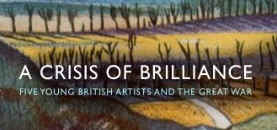
David Haycock will talk about his book

on
THURSDAY OCTOBER 29TH SOLD
OUT
TUESDAY NOVEMBER 17TH (now added)
at 7.30 PM IN THE SPENCER GALLERY
tickets £5 (concessions friends and Custodians only)
tickets on Sale from Sept 17th from the Gallery or from Maura Carr on 01628 530181
Crisis of Brilliance tells the story
of Dora Carrington, Mark Gertler, Paul Nash, Christopher Nevinson and
Stanley Spencer, who were five of the most important British artists of
the twentieth century. From diverse backgrounds they met at the Slade
School of Drawing, Painting and Sculpture in London between 1908 and 1910,
in what their teacher, Henry Tonks, later described as the School’s
‘last crisis of brilliance’. Between 1910 and 1918 they and their art
school friends loved, talked and fought; they advised, admired, conspired
and sometimes disparaged each others’ artistic ambitions and creations.
The Bloomsbury Group critic Roger Fry called them ‘les jeunes’; they
were the ‘Young British Artists’ of their day. They formed gangs and
created or joined new movements (the Slade Coster Gang, the
Neo-Primitives, the Futurists, the Vorticists); they hung out in the most
stylish cafes and restaurants in London and founded their own night-club;
they led the way in fashion with their avant-garde clothes and haircuts;
they slept with their models and with prostitutes; their tempestuous love
affairs descended into obsession, murder and suicide.
It’s not biography in the traditional sense at all but a history of art,
artists and their times and interestingly this is the first time that
there has ever been a study of these artists as a group.
David Boyd Haycock grew up in West Africa, East Anglia and North
Yorkshire; he read Modern History at St John’s College, Oxford, and Art
History at the University of Sussex, before studying for a PhD at Birkbeck
College, London. He worked in publishing, and as an archaeologist, before
becoming an academic historian and then a museum curator. His two areas of
particular interest are the intellectual history (broadly speaking) of the
seventeenth and eighteenth century, and the history of art in early to mid
twentieth-century Britain. If there is a unifying thread to his
work, it is biography. His primary interest is in how individuals express
their ideas, their personalities and their individual experiences and
engagement with the culture and society that surrounds them: be that
though ideas and beliefs (intellectual history) or paintings and drawings
(art history).